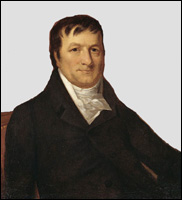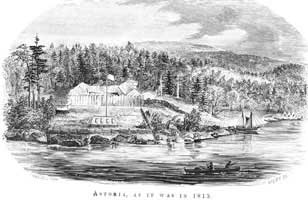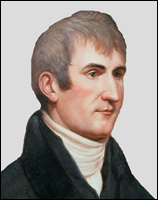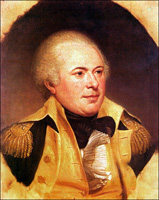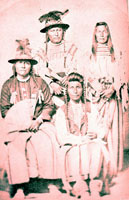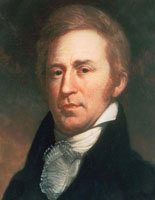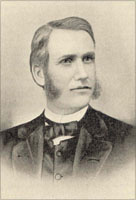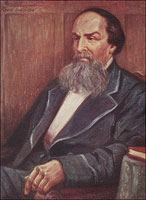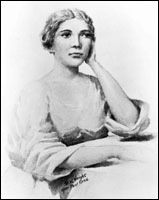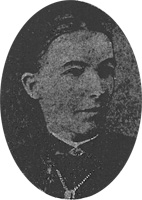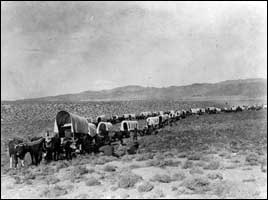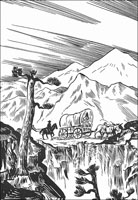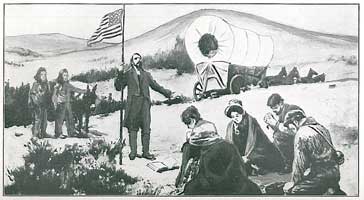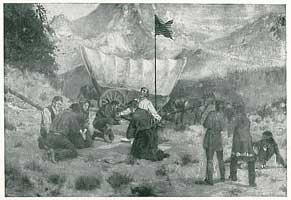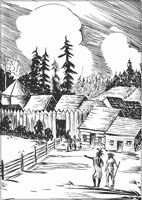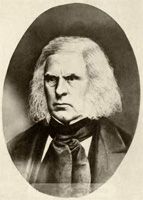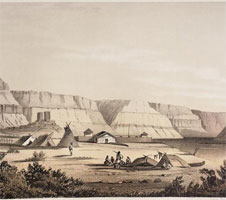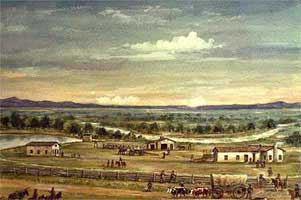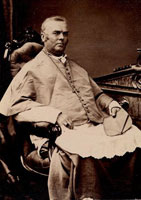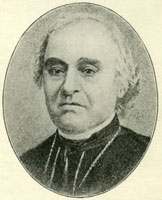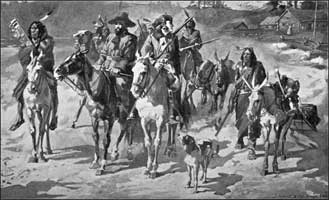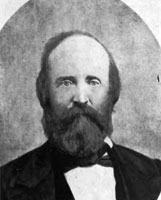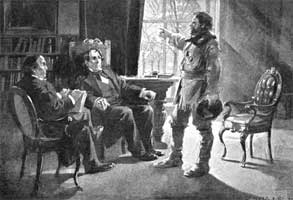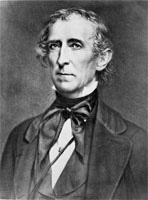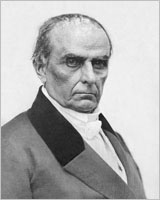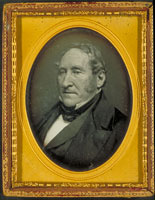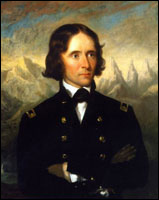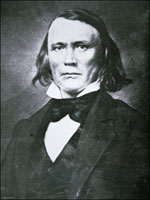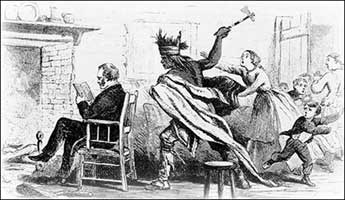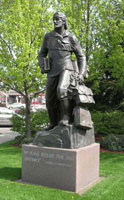You
have increased the nation (in size), O JEHOVAH, you have increased
the nation, you are glorified: |
The state that is called Oregon today was a vast area comprising the presen day states of Oregon, Washington, Idaho, as well as parts of Wyoming and Montana. All the land west of the Rocky Mountains between California and latitude 54°40 north was called Oregon.
The most important river in Oregon is the Columbia River, which was discovered by Captain Robert Gray in 1792. Captain Gray named the river after his ship the Columbia.
|
In December 1813, Captain William Black of the Hudson's Bay Company formally took possession of the fort and renamed it Fort George. After the British defeat at the Battle of New Orleans, the fort remained in the hands of the Hudson's Bay Company, and Oregon was declared a joint possession of the 2 countries.
When Meriwether Lewis of the famous Lewis and Clark Expedition arrived back in Saint Louis in September 1806, Lewis immediately wrote a letter to President Jefferson urging him to establish an outpost at the mouth of the Columbia River. President Jefferson was not interested in working with the now famous explorer, and Lewis was murdered by the Hudson's Bay Company in October 1809.
|
If Lewis had not urged Jefferson to colonize the Pacific Coast, his account of the overland journey was enough to get him killed. Lewis reported seeing the bones of huge giants, colonies of pygmies, and a tribe of Welsh Indians. His true report of the wonders of the Tabernacle of David, if published, would have demolished the Columbus Myth forever.
In 1818, a joint occupation of Oregon for 10 years was agreed between the U.S. and Britain, but terminable by a notice of one year given by either party. The future status of Oregon was debated–but not settled–when the Webster-Ashburton Treaty was signed in August 1842.
The 4 Indians' quest for the white man's Book of Heaven!!
1831 was an epochal year for the newborn United States. Around December of that year, 4 Flathead Indians of the Nez Perce tribe arrived in St. Louis The intelligent Indians had met a fur trapper from the United States and they were very anxious to know the truth about the Great Spirit:
Far up Clark's River, and central in what is now Washington Territory, beyond mountain fastnesses, they had heard from an American trapper of the white man's God, and of a spirit home, better than the hunting grounds of the blessed, and of a Book that told truly of the Great Spirit, and of that home and the trail to it. The report is that the Iroquois had given to them some of the Christian teachings which had become theirs in Colonial New York; and very likely some of the mountain trappers who left the white frontier and rude clearing, and may be the Book and family altar long years before, had done the same thing. The Indians, always religiously inclined, listened, and then inquired, and then talked it over. (Barrows, Oregon: The Struggle for Possession, p. 104).
At that time, St. Louis was the furthest outpost of civilization and a stronghold of the Latin Church. The famed William Clark of the Lewis and Clark Expedition met them in St. Louis. William Clark was an Episcopalian . . . which means a "Catholic" who failed Latin!!
|
When the mystery of transubstantiation was "explained" to them . . . they were totally perplexed....When they saw all the saloons selling firewater they also knew that they were far from finding the elusive Book of Life. Two of the Indians died in St. Louis, and when spring arrived, the two survivors prepared for the long trail home. Before departing, one of the Indians gave a sorrowful speech, lamenting their failure to find the Book of Heaven. Here is an excerpt from that speech:
My people sent me to get the"White Man's Book of Heaven. You took me to where you allow your women to dance as we do not ours, and the book was not there, You took me to where they worship the Great Spirit with candles and the book was not there. You showed me images of the good land beyond, but the book was not among them to tell us the way. I am going back the long and sad trail to my people in the dark land. You make my feet heavy with gifts and my moccasins will grow old in carrying them, yet the book is not among them. When I tell my poor blind people after one more snow, in the big council, that I did not bring the book, no word will be spoken by our old men or by our young braves. (Nixon, How Marcus Whitman Saved Oregon, pp. 52-53).
All was not lost, however, our Great JEHOVAH did come to their rescue. In 1833, the speech was translated and published in a Christian magazine, with a ringing endorsement by Willbur Fish, the president of Wesleyan University in Connecticut.
The Whitmans and Spaldings answered the "Macedonian Cry" of the Indians!!
The Indians' plea for the Gospel of Christ is similar to another history changing event that happened to the Apostle Paul. While Paul was preaching the Gospel in the Mideast, he had a vision of a man from Macedonia imploring him to come and help him:
Now when they had gone through Phrygia and the region of Galatia, they were forbidden by the Holy Spirit to preach the word in Asia. After they had come to Mysia, they tried to go into Bithynia, but the Spirit did not permit them. So passing by Mysia, they came down to Troas. And a vision appeared to Paul in the night. A man of Macedonia stood and pleaded with him, saying, “come over to Macedonia and help us.” Now after he had seen the vision, immediately we sought to go to Macedonia, concluding that JEHOVAH had called us to preach the gospel to them (Acts 16:6-10).
Saint Paul's traveling companion and biographer was a physician named Saint Luke. Saint Paul obeyed the divine call immediately, and from that time onward, his whole focus was WESTWARD: Greece, Rome, Spain, and finally Britannia.
Dr. Marcus Whitman and Henry Spalding answered the "Macedonian Cry" of the Indians. Both men were determined to bring their wives along.
|
Henry Spalding later introduced the potato to Idaho and that state now produces most of the Freedom Fries for McDonalds.
Dr. Whitman was not married when he answered the call and the missions board did not approve of sending single men to the mission field. Narcissa Prentice was also anxious to be a missionary so Providence brought the 2 young people together.
|
Saint Louis, Missouri, was the jumping-off point for the 2,000 mile journey to Oregon. The trip was too hazardous for most men and for females to make the journey was considered certain death. Nothing daunted, the 2 wives decided to risk all . . . or die in the attempt!!
All the forts along the Oregon Trail were manned by HBC men warning the women to turn back because Indian braves loved to capture paleface women for their wigwams.
|
By Divine Providence the little party reached South Pass and the Continental Divide on July 4. There they unfurled the U.S. flag, and claimed all the lands west of the Rocky Mountains for the Kingdom of Christ. It was the most sublime spectacle since the landing of the Pilgrims in 1620.
|
The fateful day the women crossed the Continental Divide the iron grip of the Hudson's Bay Company was broken forever. The 2 women were the true Pathfinders who opened the way for millions more to follow:
How beautiful upon the mountains are the feet of them that bringeth good tidings, that publisheth peace; that bringeth good tidings of good, that publisheth salvation; that saith unto Zion, "Elohim reigneth!" (Isaiah 52:7).
All the lands west of the Rocky Mountains were infested with HBC men who knew instinctively that women and wagons would mean an end to their diabolical monopoly:
Arrived at Fort Hall, about one hundred miles north of Salt Lake, all baggage and luggage were reduced as much as possible and repacked. Here all parties, mission and Hudson Bay and the Post men too, combined to say that the wagon could be hauled no farther. The terrible canyons, and bottomless creeks in the Snake Plains, made it impossible. But the iron Doctor was immovable. Then they said that he must at least take it apart and pack it, if it went on. Finally, the indomitable man made a compromise, converted the wagon into a cart, loaded the duplicate wheels and axletree, and started again on wheels for the Columbia. (Barrows, Oregon: The Struggle for Possession, p. 142).
After suffering incredible hardships that would make most men turn back, Narcissa and Eliza persevered, and the small group of missionaries finally reached Fort Vancouver in September 1836.
The arrival of the missionaries caused consternation at the Hudson's Bay fort!!
The arrival of the little group of missionaries caused alarm bells to sound at Fort Vancouver–the Oregon HQ of the Hudson's Bay Company.
|
Dr. McLoughlin advised the Whitmans to go to the Walla Walla country, about 300 miles east of Fort Vancouver on the Columbia River. With a lot of hard work, Marcus erected a house for his wife, about 25 miles from Fort Walla Walla.
|
The Cayuse Indians were taught true Christianity, they were encouraged to plant crops, and embrace the blessings of civilization:
The wilderness and the solitary place shall be glad for them; and the desert shall rejoice, and blossom as the rose (Isaiah 35:1).
True Christianity had finally established an outpost at the ends of the earth. As all hell broke loose when Saint Paul answered the "Macedonian Cry," so Satan was furious that his last domain was invaded.
|
In October 1842, Dr. Whitman was called to visit a patient at Fort Walla Walla. Whitman was invited to stay for dinner, and during the repast, a messenger arrived at the fort announcing that about 150 Papal families were on their way to augment the 40 families that were already in Oregon.
While the interested dinner party were deep in their wild-wood convivialities, a messenger arrived express down the river announcing that the colony of one hundred and forty or more had succeeded in crossing the mountains, and were near to Fort Colville–three hundred and fifty miles up the Columbia. The welcome news sent a thrill of joy along the tables, and carried the excitement of the hour to a climax. The company instantly took the import of the announcement and were jubilant. Congratulations passed from man to man. A young priest, more ardent than wise, sprang to his feet, and with a twirl of his cap, and a shout, exclaimed "hurrah for Oregon! America is too late, and we have got the country!" The more intelligent at the table may have remembered that Mr. Canning, the English minister, had expressed his determination to maintain, as British property, any footing and position which the Company might obtain in Oregon. (Barrows, Oregon: The Struggle for Possession, p. 162).
When Dr. Whitman heard the proud boast of the priest, it made his patriotic Christian blood boil....He was determined then and there to go to Washington City and plead for Oregon.
Dr. Whitman's incredible 4,000 mile journey to save Oregon for the U.S. of Israel
Though it was late in the year, and winter was approaching, Dr. Whitman was determined that nothing would stop him from reaching Washington City and pleading for Oregon. He knew that the status of Oregon was being negotiated that very year . . . and he hoped to reach the President . . . before it was too late.
|
Whitman was certainly not counting on "Manifest Destiny" to keep Oregon out of the grasp of the HBC....He was in such a rush to leave that he forgot his compass. At one point in the incredible journey, the party could not find their camp, so they had to rely on his mule to show them the way....No, he didn't talk . . . he just moved his ears in the direction of their camp....Asa and the party accompanied him as far as Bent's Fort on the Arkansas River and Whitman went the rest of the way alone.
Because of the deep snow in the Rocky Mountains, Whitman was diverted south through Taos, New Mexico, and this diversion added another 1,000 miles to his incredible journey. On March 3, with a lot of prayer, he arrived in Washington City penniless, and wearing tattered rags.
|
Daniel Webster was President Tyler's Secretary of State, he was pro-British, and a "friend" of Hudson's Bay Company governor Sir George Simpson. Webster was quite willing to trade Oregon for some crumbs under the table like fishing rights in New Brunswick.
|
The most convincing argument that Whitman made was the fact that his wife accompanied him to Oregon. His plea was also reinforced by the fact that wagons could be taken over the Rocky Mountains. It was understood also that only occupation by immigrants would settle the destiny of Oregon, so the government began to urge families to move to Oregon. At that time, U.S. women obeyed Saint Paul's injunction to marry and have children.
Before returning to Oregon, Dr. Whitman visited the Mission Board in Boston that sent him out 6 years previously. They were incensed, and rebuked him sternly for leaving his "few sheep in the wilderness" in order to make his incredible journey to save Oregon!!
The Great Migration of 1843
Encouraged by the President and politicians in Washington City, a supernatural impulse moved thousands of families to move to Oregon. John C. Fremont was the son-in-law of the powerful senator, Thomas Hart Benton. Frémont made a trip westward in 1842, but returned later that same year.
|
In what was dubbed "The Great Migration of 1843" or the "Wagon Train of 1843," an estimated 700 to 1,000 emigrants left for Oregon. They were led initially by John Gantt, a former U.S. Army Captain and fur trader who was contracted to guide the train to Fort Hall for $1 per person. Whitman joined the wagon train at the Platte River for the return trip. When the pioneers were told at Fort Hall by agents from the Hudson's Bay Company that they should abandon their wagons there and use pack animals the rest of the way, Whitman disagreed and volunteered to lead the wagons to Oregon. He believed the wagon trains were large enough that they could build whatever road improvements they needed to make the trip with their wagons. The biggest obstacle they faced was in the Blue Mountains of Oregon where they had to cut and clear a trail through heavy timber. The wagons were stopped at The Dalles, Oregon, by the lack of a road around Mount Hood. The wagons had to be disassembled and floated down the treacherous Columbia River and the animals herded over the rough Lolo trail to get by Mt. Hood. Nearly all of the settlers in the 1843 wagon trains arrived in the Willamette Valley by early October. A passable wagon trail now existed from the Missouri River to The Dalles.
The Massacre of the Whitmans by the Hudson's Bay Company!!
The "Great Migration of 1843" was the handwriting on the wall for the Hudson's Bay Company and their priests. They looked with envy on the new immigrants and their successful cultivation of the land.The Oregon Treaty was signed in Washington City on June 15, 1846, It settled the boundary at the 49th parallel and the joint occupation ended. The Hudson Bay Company looked upon the treaty as just a temporary measure until admiral Seymour seized California.
|
The wrath of the Hudson's Bay Company and their priests was fierce when they lost Oregon . . . and California....A series of events was set in motion by the Company to murder the Whitmans in cold blood:
An epidemic of smallpox began to kill many of the Indians and the priests told them that the missionaries had come to kill them and take their land: Undoubtedly the sickness of the Indians, that year, and the charge that the Americans had introduced the disease to kill the Indians off and get their land, was a powerful agent in winning over to the murderers many who were still friendly to the Missionaries. The Indians had fallen from their high mark of honesty of which Mrs. Whitman in her diary, years before, boasted, and had invaded the melon patch and stolen melons, so that the Indians who ate them were temporarily made sick. With their superstitious ideas they called it "conjuring the melon," and the incident was used effectually to excite hostilities.(Nixon, How Marcus Whitman Saved Oregon, p. 222).
The massacre could have been far worse, but the Jesuits could not persuade the Indians to be as bloodthirsty as they were in France.
The senseless massacre did nothing to stem the tide of emigration. Oregon became the 33rd state in February 1859 and its capital is called SALEM.
Vital links
References
Barrows, William. Oregon: The Struggle for Possession. Houghton, Mifflin and Company, Cambridge, MASS, 1884.
Dewhusrt, Richard J. The Ancient Giants Who Ruled America: The Missing Skeletons and the Great Smithsonian Cover-up. Bear & Co., Rochester, Vermont, 2014.
Dolan Eric Jay. Fur, Fortune, and Empire: the Epic History of the Fur Trade in America. W.W. Norton & Co., New York, 2010.
Dye, Eva Emery. McLoughlin and Old Oregon. Wilson-Erickson,Inc., New York, 1936.
Drury, Clifford Merrill. Where Wagons Could Go: Narcissa Whitman & Eliza Spalding. University of Nebraska Press, Lincoln, 1963.
Fell, Barry, America B.C. Ancient Settlers in the New World. Pocket Books, New York, 1976.
Grey, William Henry. A History of Oregon, 1792–1848. Harris & Hollman, Portland, Oregon, 1870.
Nixon, Oliver, W. How Marcus Whitman Saved Oregon. Star Publishing Co., Chicago, 1895.
Stark, Peter. Astoria: John Jacob Astor and Thomas Jefferson's Lost Pacific Empire. HarperCollins, New York, 2014.
Starrs James E. & Cale, Kira. The Death of Meriwether Lewis. A Historic Crime Scene Investigation. River Junction, Press, Omaha, NE, 2009.
Terrell, John Upton. Furs By Astor. William Morrow & Co., New York, 1963.
Copyright © 2014 by Patrick Scrivener
